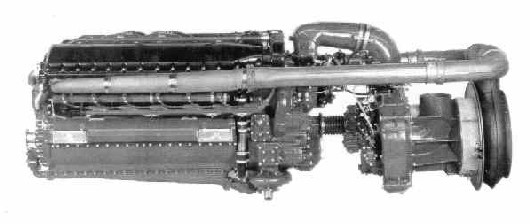The first V 17 10
produced 750 hp. By the beginning of World War 11
it was producing 1050 hp, then 1125, then 1325,
and late model P‑38's got 1475. But engineers
recognized that there was a lot of energy going
out the exhaust pipes.
An attempt to
recover some of this energy resulted in the
turbo-compound V1710 shown at the bottom of the
page. It was identified as the V1710‑E22 by
Allison, and as the V1710‑127 by the government. A
turbo-compound engine collects all of the exhaust
gasses and runs them through a turbine, with all
of the power generated going back into the
crankshaft and ultimately to the propeller. It
differs from a turbo-supercharged engine, which
uses exhaust gas energy to increase the pressure
of incoming air. Work on this engine began in
about 1944 and continued until 1946, when Allison
asked that it be cancelled because turbine engines
had greater promise. It was the first successful
turbo-compound engine, and probably one of only
three to ever be built. This engine was designed
to power the XP63H, which, as it turned out, never
flew. The V1710‑E22 had a military rating of 2320
hp, and a War Emergency Rating with water/alcohol
injection of 3090 hp.
The most successful
turbo-compound engine was a version of the
air‑cooled, 18‑cylinder, two‑row radial Curtiss
Wright R3350. This engine had three turbines, each
fed by 6 cylinders, that were geared to the
crankshaft. The normal version produced 2700 hp
and weighed 2850 lbs. The turbo-compounded version
produced 3500 hp and weighted 3440 lb. This engine
was used on the Douglas DC‑7 and some versions of
the Lockheed Constellation. The other
turbo-compound engine is the Napier Nomad, which
was built in England. It was a 12‑cylinder,
horizontally opposed, liquid cooled, valve-less,
2‑stroke cycle Diesel engine with a 3‑stage
turbine. It reached flight test but not
production.
The Allison engine
collected the exhaust gas from all 12 cylinders
and routed it to the turbine at the rear of the
engine through two exhaust tubes. The shaft from
the turbine ran through the centre of the first
stage supercharger impeller, back to the engine
and put its power directly into the crankshaft.
The turbine could not be connected to the
supercharger impeller because the supercharger was
driven by a variable speed transmission, which did
not run at a fixed speed ratio with respect to
either the crankshaft or the turbine. Since this
engine was to power a P‑63, it used an extension
shaft and a remote gearbox attached to the
crankshaft at the front of the engine at lower
left in the picture below. This engine represented
quite an advancement over the original 750 hp
engine.

